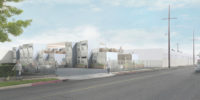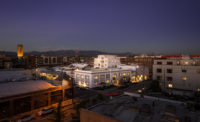Los Angeles is currently “reaching a saturation point,” says Sam Lubell, who with fellow curator Danielle Rago created Shelter: Rethinking How We Live in Los Angeles, the inaugural exhibition for the Architecture + Design (A+D) Museum’s new home in the city’s Downtown Arts District (on view now through November 6). Decades of migration to L.A.'s sunny skies have led to unprecedented strain: The Los Angeles County population hovers around 10 million and the city is entering year five of a debilitating drought. Meanwhile, housing prices have soared.
With expansion into the desert no longer an environmentally or logically feasible solution, the two curators commissioned six local firms—Bureau Spectacular, LA-Más, Lorcan O’Herlihy Architects (LOHA), MAD Architects, PAR, and wHY—to explore housing solutions that would address urgent needs of density, affordability, and sustainability. The exhibition focuses on two sites currently undergoing major changes: the L.A. River—where a vast concrete drainpipe is currently being overhauled by Frank Gehry—and the Wilshire corridor—the site of the Metro’s forthcoming Purple Line extension and whatever subsequent effects it may bring. (One of them being the A+D Museum’s move to a new location: its former building on Miracle Mile is set to be demolished to make way for a new train station.)
Left to their own devices, the firms have put together an architectural version of a science fair: presentation boards and scale models display their hypotheses in the museum’s new downtown space.
With the exception of the non-profit design lab LA-Más, which articulated a thoughtful proposal to shore up the dangers of gentrification and displacement along the L.A. river through policy changes and combined housing lots, the presentations lean more towards the conceptual. The best of them shine an implicit light on the particular shortcomings and oddities that define urban planning in L.A. wHY, the Venice-based firm founded by Kulapat Yantrasast, built a model of Wilshire Boulevard in which houses occupy the spaces previously devoted to cars. The seemingly endless road was built as a circular loop that revolves as a Ferris wheel, and Band-Aid boxes, landline phones and other sundries stand in for the houses, a tacit commentary on what Yantrasast calls “the hodgepodge architectural expressions” the city is known for. Lorcan O’Herlihy addressed the absurdity of a near-desert city lacking any efficient means of capturing water on the rare occasions it does rain. LOHA proposes houses outfitted with large-scale sponges and bladders that could trap water and deposit it directly into an aquifer, which would be a shared commodity among dense communities.
Jimenez Lai of Bureau Spectacular seemed to eschew the design brief that called for proposals to resolve L.A.’s housing crises, but instead dreamt up idealized caricature homes best suited for the eccentricities of L.A. life. He offers rooms connected by the outdoors rather than hallways; rooftop pools that create beautifully sculpted ceilings; and his own take on the historical inaccuracies of the Queen Anne revival style, each cleverly embedded with references to L.A. culture, such as a nod to the art of Mike Kelley and Southern California’s love for all things green.
The exhibition’s experimental spirit as a whole brings to mind the heyday of Los Angeles residential architecture, when architects like Rudolf Schindler and Richard Neutra, and even Frank Lloyd Wright played with the particularities of the climate to produce entirely new forms and philosophies of the home—in L.A.'s case, mainly utopian retreats complete with private gardens (or pools). It also offers an alternative reality to the current starkly uninspired housing options, full of predictable units put forth by developers. With the era of case study houses long passed, by now we should be inventing something new.




















Post a comment to this article
Report Abusive Comment